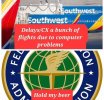Oops, I meant to type 777
I had an Airbus lose one while we were trundling from Philly to LA, and when they pulled it to idle we turned and started heading for Denver. When they shut it down, we skipped Denver and landed at the nearer airport of Colorado Springs, even though Denver was just up the road. That's what surprised me about this flight path.
Looking...it actually made the news. The internet remembers...

US Airways flight makes emergency landing in Colo.
US Airways flight makes emergency landing in Colo.www.denverpost.com
Fuel load, urgency of the malfunction, location of maintenance support, and company policy all played a role there, I'm sure. If you have to dump down anyway, why rush it to land in London? In the big scheme of things, Paris really isn't that far, especially since I bet they had a lot of checklist items to complete, and gross weight to adjust.
Plus they'd have missed their chance to draw what I'm now referring to as the "crooked French sky penis".





